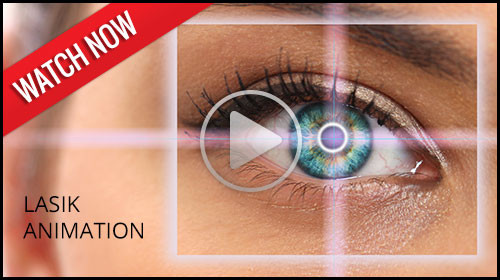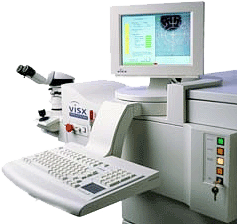
LASIK, a form of refractive surgery, is an option for vision correction without needing to wear glasses or contact lenses. Simply put, LASIK reshapes the cornea with a laser.
Recently, other surgical alternatives have become available. Among these is a technique called phakic IOL implantation which involves implanting a lens behind the cornea, but in front of the iris. With this new option, many of those who were too highly nearsighted for LASIK are now candidates for refractive surgery.
 If you are interested in refractive surgery, please let us know. Refractive surgery is not to be taken lightly. Detailed testing is necessary to determine whether or not you are a good candidate for the surgery. If testing shows you to be a good candidate, we can help you choose the refractive surgeon who is most appropriate for your case. In addition, we provide post-operative care for refractive surgery.
If you are interested in refractive surgery, please let us know. Refractive surgery is not to be taken lightly. Detailed testing is necessary to determine whether or not you are a good candidate for the surgery. If testing shows you to be a good candidate, we can help you choose the refractive surgeon who is most appropriate for your case. In addition, we provide post-operative care for refractive surgery.
Paula Hearld
I had contemplated the LASIK procedure for quite a while before I approached Dr. Peterson. Because I wore hard contact lenses for over 20 years, Dr. Peterson warned me that I might have a 6-12 month waiting period because my eyes needed to return to their original state before LASIK. The wait was well worth it. Now I love getting up in the morning without fumbling for my glasses.
What is SMILE?
Minimally invasive surgery for correcting vision
Small Incision Lenticule Extraction with SMILE is the most recently developed type of laser eye surgery. It’s a minimally invasive procedure that can correct various vision impairments such as nearsightedness and astigmatism.
It’s a popular option, with over 1.400 clinics and more than 2.500 practicing surgeons worldwide who use SMILE. Millions of eyes with myopia and/or astigmatism have been corrected with SMILE in over 80 countries.
How does SMILE work?
SMILE is running on a femtosecond laser to reshape the cornea. This femtosecond laser is an extremely short-pulsed, near infrared laser often also used to create a LASIK flap. The laser's high peak intensity over a very short pulse duration (within a few femtoseconds of time) allows it to create micro-precision single holes (bubbles) that forms together cuts or planes in the corneal tissue without affecting the surrounding tissue.
It takes less than 30 seconds for the laser to create a small lens-shaped piece of corneal tissue (called the lenticule) inside the cornea. The surgeon then removes the lenticule through a small incision outer part of the eye. This reshapes the cornea and corrects the refractive error.
The femtosecond laser produces a thin layer just beneath the surface of the eye, and at the same time creates a small opening. It’s an almost silent, noiseless, odorless procedure and the patient can remain in the same position from start to finish.
 |
Step 1: Creation of the lenticule with the laser |
 |
Step 2: Removal of the lenticule through a small side incision |
 |
Step 3: Correction of the refraction error or prescription is complete |



